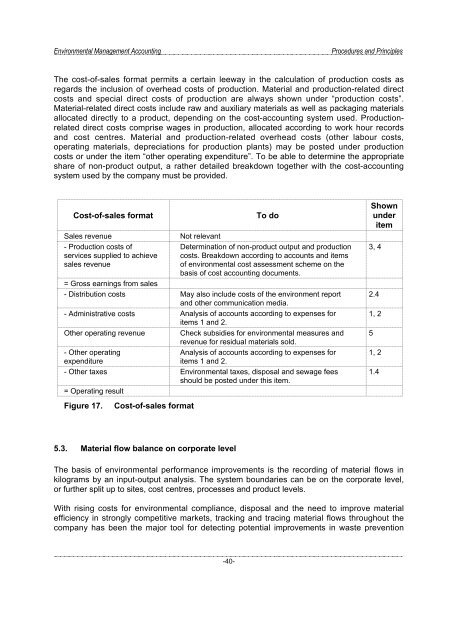Environmental Management Accounting Procedures and Principles
Environmental Management Accounting Procedures and Principles
Environmental Management Accounting Procedures and Principles
Create successful ePaper yourself
Turn your PDF publications into a flip-book with our unique Google optimized e-Paper software.
<strong>Environmental</strong> <strong>Management</strong> <strong>Accounting</strong><br />
<strong>Procedures</strong> <strong>and</strong> <strong>Principles</strong><br />
The cost-of-sales format permits a certain leeway in the calculation of production costs as<br />
regards the inclusion of overhead costs of production. Material <strong>and</strong> production-related direct<br />
costs <strong>and</strong> special direct costs of production are always shown under “production costs”.<br />
Material-related direct costs include raw <strong>and</strong> auxiliary materials as well as packaging materials<br />
allocated directly to a product, depending on the cost-accounting system used. Productionrelated<br />
direct costs comprise wages in production, allocated according to work hour records<br />
<strong>and</strong> cost centres. Material <strong>and</strong> production-related overhead costs (other labour costs,<br />
operating materials, depreciations for production plants) may be posted under production<br />
costs or under the item “other operating expenditure”. To be able to determine the appropriate<br />
share of non-product output, a rather detailed breakdown together with the cost-accounting<br />
system used by the company must be provided.<br />
Cost-of-sales format<br />
Sales revenue<br />
- Production costs of<br />
services supplied to achieve<br />
sales revenue<br />
To do<br />
Not relevant<br />
Determination of non-product output <strong>and</strong> production<br />
costs. Breakdown according to accounts <strong>and</strong> items<br />
of environmental cost assessment scheme on the<br />
basis of cost accounting documents.<br />
= Gross earnings from sales<br />
- Distribution costs May also include costs of the environment report<br />
<strong>and</strong> other communication media.<br />
- Administrative costs Analysis of accounts according to expenses for<br />
items 1 <strong>and</strong> 2.<br />
Other operating revenue Check subsidies for environmental measures <strong>and</strong><br />
revenue for residual materials sold.<br />
- Other operating<br />
expenditure<br />
Analysis of accounts according to expenses for<br />
items 1 <strong>and</strong> 2.<br />
- Other taxes <strong>Environmental</strong> taxes, disposal <strong>and</strong> sewage fees<br />
should be posted under this item.<br />
= Operating result<br />
Shown<br />
under<br />
item<br />
3, 4<br />
2.4<br />
1, 2<br />
5<br />
1, 2<br />
1.4<br />
Figure 17.<br />
Cost-of-sales format<br />
5.3. Material flow balance on corporate level<br />
The basis of environmental performance improvements is the recording of material flows in<br />
kilograms by an input-output analysis. The system boundaries can be on the corporate level,<br />
or further split up to sites, cost centres, processes <strong>and</strong> product levels.<br />
With rising costs for environmental compliance, disposal <strong>and</strong> the need to improve material<br />
efficiency in strongly competitive markets, tracking <strong>and</strong> tracing material flows throughout the<br />
company has been the major tool for detecting potential improvements in waste prevention<br />
-40-




